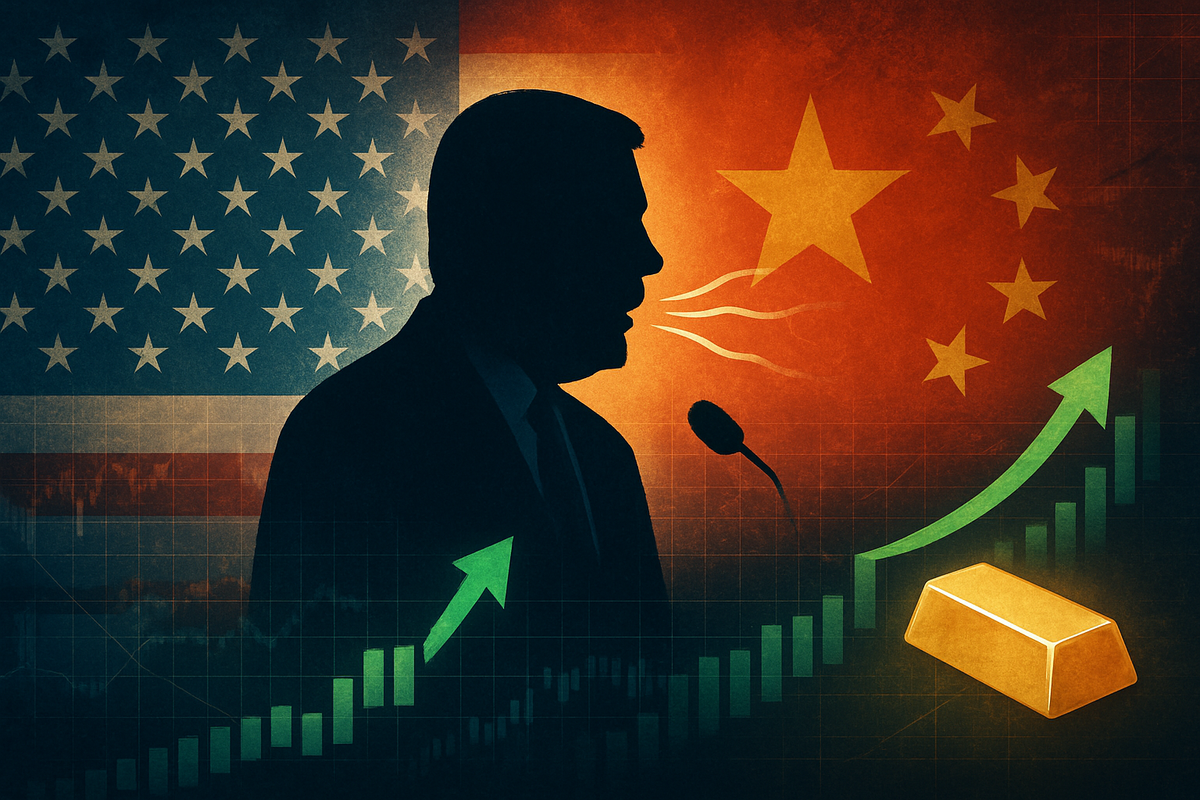
In a dramatic shift that sent ripples of relief through global financial markets, US equity futures trimmed significant losses and stocks rallied after President Donald Trump's remarks eased mounting trade fears with China. The conciliatory tone, following a period of heightened tensions and aggressive tariff threats, provided a much-needed respite for investors, causing safe-haven assets like gold to retreat from fresh record highs. The event, unfolding in mid-October 2025, underscored the profound sensitivity of markets to political rhetoric, particularly concerning the volatile US-China trade relationship.
The market's immediate turnaround was a direct response to President Trump's statements, which hinted at a de-escalation of the trade dispute and confirmed an upcoming meeting with Chinese President Xi Jinping. While the Dow Jones Industrial Average (INDEXDJX: .DJI) and broader stock indices saw gains, the rally was tempered by lingering concerns over the health of regional US banks and an ongoing government shutdown, reminding investors of the multifaceted challenges facing the economy.
Trump's De-escalation Halts Market Plunge Amidst Trade War Fears
The period immediately preceding President Trump's calming remarks was marked by escalating US-China trade tensions that had sent shockwaves through global markets. On October 9, 2025, China announced stricter export controls on rare earth materials, critical components for many high-tech industries. In a swift retaliation on October 10, President Trump threatened to impose an additional 100% tariff on Chinese imports, effective November 1, and announced new restrictions on "any and all critical software" exports. He also initially suggested calling off a crucial meeting with Chinese President Xi Jinping, intensifying fears of a full-blown trade war. This aggressive stance led to a sharp market downturn, with the S&P 500 (INDEXSP: .INX) sinking 2.7% and the Nasdaq Composite (INDEXNASDAQ: .IXIC) tumbling 3.6%, wiping out approximately $2 trillion from US equity markets. Amid this uncertainty, safe-haven assets surged, with spot gold hitting a fresh record of $4,379.70 per ounce, further fueled by expectations of a Federal Reserve rate cut and concerns over an ongoing US government shutdown.
However, the narrative shifted dramatically over the weekend of October 12-13, 2025. President Trump began to temper his rhetoric, posting on Truth Social: "Don't worry about China, it will all be fine! Highly respected President Xi just had a bad moment. He doesn't want depression for his country, and neither do I. The U.S.A. wants to help China, not hurt it!!!" Building on this, in an interview with Fox Business Network aired on Friday, October 17, Trump explicitly stated that the proposed 100% tariffs on Chinese goods "would not be sustainable" and "will not stand." Crucially, he also confirmed his intention to meet with President Xi in South Korea, a week after having threatened to cancel the summit. These comments were a noticeable softening of his earlier aggressive posture and served as the primary catalyst for the market's positive reaction.
The immediate market response was a significant relief rally. US stock futures, including those for the Dow Jones, S&P 500, and Nasdaq, rose sharply, trimming previous losses. The Dow Jones Industrial Average, for instance, gained 1% at the opening bell, recovering from earlier sell-offs. Conversely, gold prices, which had soared to record highs on trade war fears, experienced a notable pullback, falling from above $4,300 to around $4,226 per ounce. This "tariff whiplash" demonstrated how sensitive markets were to political rhetoric, with investors reacting to the changing tone rather than solely underlying economic fundamentals.
Corporate Winners and Losers in the Easing Trade Winds
The easing of US-China trade tensions and the softening stance on tariffs have immediate and significant implications for a wide array of public companies and sectors. Generally, businesses deeply embedded in global supply chains and those with substantial exposure to the Chinese market stand to gain, while some domestic industries that benefited from protectionist measures might see their competitive edge diminish.
The Technology Sector is a major beneficiary. Companies like Apple (NASDAQ: AAPL), with extensive manufacturing in China, would see stabilized supply chains and lower input costs on components and finished goods, potentially boosting profit margins and sales. Semiconductor companies such as Nvidia (NASDAQ: NVDA), AMD (NASDAQ: AMD), Marvell (NASDAQ: MRVL), Taiwan Semiconductor (NYSE: TSM), ASML (NASDAQ: ASML), and Intel (NASDAQ: INTC) would benefit from reduced production bottlenecks and lower costs. US-listed Chinese tech giants like Alibaba (NYSE: BABA), JD.com (NASDAQ: JD), and Baidu (NASDAQ: BIDU) would also experience eased pressures on their supply chains and market access. However, some companies, like MP Materials (NYSE: MP), a U.S. rare earth producer, which saw stock surges amid China's export restrictions, might see a reduction in the speculative premium on domestic production if tensions truly ease.
In the Manufacturing Sector, automakers and companies with global supply chains are set to win. The U.S. automotive industry, including Tesla Inc. (NASDAQ: TSLA), could benefit from lower input costs on metals and electronics due to tariff reductions. Manufacturers producing goods in China for export to the U.S. would see reduced tariff burdens and improved market access, boosting revenue and profitability. Logistics and shipping companies like ZIM Integrated Shipping (NYSE: ZIM), Matson (NYSE: MATX), FedEx (NYSE: FDX), and UPS (NYSE: UPS) would also likely see increased volumes and efficiency. Conversely, domestic manufacturers that thrived under tariff protection might find their competitive advantage slightly diminished.
The Agriculture Sector stands to gain significantly. U.S. agricultural producers, particularly soybean and pork farmers, are highly sensitive to trade relations. Any sustained de-escalation could reopen critical export markets, benefiting companies like Archer-Daniels-Midland (NYSE: ADM) and Bunge Limited (NYSE: BG). China is the largest global importer of soybeans, and renewed dialogue could restore market access and stabilize prices for these producers.
Finally, the Retail Sector would also see positive impacts. Multinational retailers like Walmart (NYSE: WMT) that import goods from China would benefit from lower or removed tariffs, translating to reduced costs for consumer goods. This could lead to lower prices for consumers and improved profit margins for retailers. Apparel and footwear companies such as Nike (NYSE: NKE), Foot Locker (NYSE: FL), Dick's Sporting Goods (NYSE: DKS), Under Armour (NYSE: UAA), and American Eagle Outfitters (NYSE: AEO), many of which have significant production in China, would also see reduced input costs and improved consumer sentiment from eased tensions. While an easing of tensions is largely positive for this sector, companies that heavily diversified their supply chains away from China due to previous tariffs might need to re-evaluate their strategies.
Wider Significance: A Pause in the Storm, Not an End to Trade Politicization
President Trump's statements easing US-China trade fears, while providing temporary market relief, carry a wider significance that reflects deeper industry trends, influences competitor dynamics, highlights regulatory complexities, and echoes historical patterns of political rhetoric's market impact. This event is best viewed as a pause in an ongoing, structurally complex, and often politicized trade relationship rather than a definitive resolution.
The frequent fluctuations in trade rhetoric have significantly accelerated several broader industry trends. The concept of "China+1" strategies, where multinational corporations diversify their supply chains away from over-reliance on China, has gained irreversible momentum. Companies are shifting portions of production to countries like Vietnam, India, and Mexico to build resilience against geopolitical risks. This move towards reshoring and nearshoring, though costly, is a long-term strategic adaptation. Furthermore, the episode underscores the increasing politicization of global trade, forcing businesses to navigate an environment where political statements, even via social media, can dramatically influence market conditions and supply chain stability. The push for technological decoupling, especially in critical sectors like semiconductors, continues unabated, leading to fragmented ecosystems in high-tech industries despite any temporary trade truces.
The ripple effects on competitors and partners are evident. Multinational corporations with substantial operations in both the US and China are the primary beneficiaries of reduced operational costs and improved market access from eased tensions. However, the erratic nature of trade policy undermines long-term economic resilience and encourages third countries to "hedge" their bets, expanding regional trade agreements often without US involvement, potentially altering global alliances. When tensions subsequently escalate, increased tariffs lead to higher input costs, reduced consumer demand, and a general slowdown in global trade, negatively affecting economies reliant on exports.
The regulatory and policy implications of such trade rhetoric are profound. Presidential statements, even through unconventional channels, frequently move markets more dramatically than traditional economic indicators, creating an environment where policy ambiguity complicates risk assessments for businesses. The "America First" agenda, underpinning much of this rhetoric, aims to reduce the US trade deficit through aggressive use of trade remedies and by linking trade concessions to broader policy goals. This creates significant challenges for businesses trying to plan and ensure compliance with rapidly evolving trade regulations, highlighting the need for robust "what-if" scenario planning. The focus on critical materials like rare earth elements within the trade dispute also underscores vulnerabilities in highly concentrated global supply chains, prompting policy discussions around national security and high-technology manufacturing independence.
Historically, political statements and geopolitical events have always influenced financial markets. From Brexit to the Russia-Ukraine invasion, and even presidential election campaigns, uncertainty and volatility are common market responses. The Trump administration's tariff announcements were a notable example of a president's direct market impact, often moving markets significantly. This recent de-escalation fits into this pattern, demonstrating the powerful, immediate market impact that presidential rhetoric can wield, even if the underlying structural issues remain unresolved.
What Comes Next: Navigating Continued Volatility and Strategic Shifts
The recent easing of US-China trade fears, while a welcome development, ushers in a period of cautious optimism rather than a definitive end to trade volatility. From October 2025 onwards, businesses and investors must prepare for a landscape defined by continued strategic competition, punctuated by intermittent de-escalations.
In the short-term (October 2025 - Early 2026), the immediate outlook suggests a continuation of the market rebound and potential for renewed, high-level dialogue. The upcoming meeting between President Trump and President Xi Jinping in South Korea is a critical event, acting as both a pressure point and an opportunity for diplomatic breakthroughs. Economists anticipate that a temporary extension of any tariff escalation pause is likely, providing a window for further talks on contentious issues like rare earth export controls. However, the underlying tensions and the unpredictable nature of trade policy mean that market volatility will persist, with rapid shifts in sentiment based on fresh statements or developments.
Looking at the long-term (Beyond 2026), despite periodic de-escalations, the overarching trend points towards persistent competition and strategic disengagement, often termed "decoupling" or "de-risking." Even if tariffs are reduced or paused, fundamental issues like intellectual property theft, state subsidies, market access, and national security concerns are unlikely to disappear. Several scenarios are envisioned: a "drift" scenario of continuous tension managed by "on-the-brink diplomacy"; a "blocs" scenario where the world splits into economic and diplomatic coalitions; or an "uneasy coexistence" scenario with limited cooperation but avoided conflict. A less likely outcome is a truly "stabilized trade" in the 2030s. The current average US tariffs on Chinese goods (around 57.6%) and China's on US exports (32.6%) remain historically high, continuing to shape trade flows and investment decisions.
Businesses are already implementing significant strategic pivots and adaptations. Supply chain diversification, often through a "China +1" strategy, is paramount, with companies expanding production to countries like Vietnam, India, and Mexico. This increases complexity and costs but is viewed as long-term "insurance" against trade shocks. Companies are also adjusting cost structures and pricing to absorb or pass on tariff impacts, and accelerating efforts towards technological self-sufficiency and localized innovation, particularly in China. Global tax and operating models are being re-evaluated, and strong, diversified supplier relationships are becoming crucial. Chinese companies are increasingly focusing on domestic demand and expanding into new markets in ASEAN, Africa, and Latin America to mitigate US tariff risks.
For emerging markets, the US-China trade dynamics present both opportunities and challenges. Countries like Vietnam, Mexico, and India are benefiting from manufacturing relocation, seeing increased export volumes and capital inflows. However, challenges include the broader application of tariffs, continued reliance on Chinese intermediate goods, increased operational costs in new manufacturing hubs, and the overarching impact of a global trade slowdown.
The potential scenarios and outcomes for US-China trade relations remain fluid. A "verbal escalation, agreement paved" scenario suggests continued tough rhetoric that ultimately leads to a framework agreement, with the US not implementing the most extreme tariff threats and China selectively enforcing controls. A "temporary tactical escalation" might see policies implemented but later reverted due to high economic costs. Conversely, "persistent escalation and decoupling" could involve intensified tariff hikes and a strong push towards economic separation, leading to a fragmented global economy. The most extreme, though least desirable, is a "war" scenario involving military conflict. The prospect of a second Trump administration in 2025 (given the current date) is widely anticipated to intensify trade confrontations, characterized by an unpredictable approach focused on immediate economic interests.
Wrap-up: Agile Navigation in an Unpredictable Market
The recent de-escalation of US-China trade tensions, triggered by President Trump's softened rhetoric, served as a potent reminder of the profound impact political statements have on global financial markets. While US Futures trimmed losses and stocks rallied, and safe-haven gold retreated from record highs, the underlying complexities and vulnerabilities of the global economy persist.
Key takeaways from this event include the immediate, positive market rebound driven by the de-escalation of tariff threats, particularly Trump's assertion that proposed 100% tariffs "will not stand" and his confirmation of an upcoming meeting with President Xi Jinping. However, this relief was tempered by persistent concerns over the credit health of regional US banks and an ongoing federal government shutdown, highlighting that market anxieties are multifaceted. The dramatic shift in sentiment underscored the immense power of presidential rhetoric to rapidly reverse market trends, even if temporarily.
Moving forward, the market is expected to exhibit cautious optimism, but volatility will remain a constant. The de-escalation is likely to facilitate renewed high-level dialogue, potentially leading to targeted agreements. However, the fundamental competitive dynamics between the US and China, especially concerning technology, market access, and national security, ensure that trade relations will remain a contentious area for the foreseeable future. The event provided a critical, albeit potentially temporary, reprieve, indicating that while immediate fears were eased, the structural issues in US-China trade relations are far from resolved.
For investors, vigilance is paramount in the coming months. They should closely monitor any further statements or actions from both the US and Chinese administrations regarding trade, as actual implementation of agreements or renewed escalations will dictate market trajectory. Upcoming corporate earnings reports, particularly from multinational corporations with significant exposure to both economies, will offer crucial insights into real-world impacts. Developments in the regional banking sector, including earnings, loan loss provisions, and credit quality, will be key indicators of broader financial stability. The Federal Reserve's monetary policy stance, particularly on interest rates, will continue to influence asset valuations, as will the resolution or continuation of the US government shutdown. Finally, investors should keep a close eye on the long-term trend of global manufacturing network restructuring, a strategic shift that is expected to evolve regardless of short-term trade de-escalations.
In essence, while the market may breathe a collective sigh of relief, the path ahead remains complex and requires agile navigation, strategic foresight, and a keen awareness of both political rhetoric and underlying economic fundamentals.
This content is intended for informational purposes only and is not financial advice





